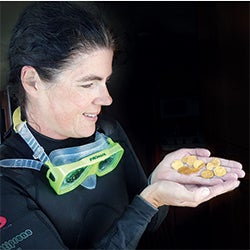As an underwater archaeologist, Bridget Buxton is trained to search for knowledge, not sunken treasure. But her most recent expedition to Israel dug up plenty of both.
When scuba divers in Israel’s eastern Mediterranean spotted some old coins, they alerted the Israel Antiquities Authority Maritime Unit Director Jacob Sharvit, which led to the recovery of over 3,000 gold coins inside the ancient Roman port of Caesarea Maritima. It was the biggest hoard of gold coins ever discovered in Israel.
Buxton and her Israeli colleagues worked with marine robotics engineers from the University of Zagreb to make a detailed map of the site before anything else was moved. “The excavation of a site destroys it,’’ she said, “so we needed to record all possible clues that existed.’’
After mapping the site, Buxton and her colleagues discovered a second pocket of coins. The most important discovery, however, was a 10-centimeter iron spike with coins cemented to either end, evidence that the gold came from a wooden shipwreck. The purpose of the coins remains a mystery.
“We guess that the ship was coming in to Caesarea sometime shortly after 1036 A.D. and struck one of the semi-submerged ruins of the old Roman breakwater,’’ Buxton said. “What we don’t understand is how such a large amount of gold was never recovered, since the ship sank so close to shore.’’
Many of the coins are from the reign of a controversial Caliph, al-Hakim, a revered figure in the Druze branch of Shia Islam, she said. The discovery is important to the Druze community, and has many implications for understanding the history of Caesarea under the rule of a medieval Egyptian dynasty called the Fatimids.

